Abstract: Of the many gifted directors within Japanese animation, arguably the most imaginative and certainly the most prolific is Miyazaki Hayao. Miyazaki’s works over the last three decades have consistently dealt with catastrophe on both a personal and a universal level, often focusing on young people and their reactions to a devastated world. This paper examines the treatment of disaster in the films, concentrating particularly on his most recent film Gake no ue no Ponyo, (Ponyo). Ponyo is discussed in the context both of Miyazaki’s general treatment of disaster and in relation to the tsunami of March 11.
Keywords: Miyazaki Hayao, animation, tsunami, apocalypse, disaster, popular culture
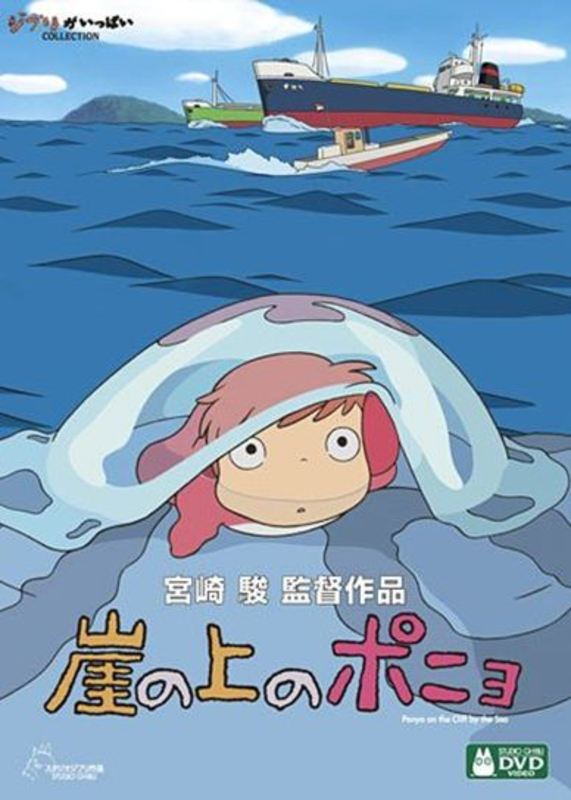
Miyazaki’s Ponyo |
As news reports of the March 11 earthquake and tsunami increased in number and intensity last spring I found myself thinking more and more about Japan’s most famous animation director Miyazaki Hayao. More specifically I thought about his most recent movie Ponyo (in Japanese, “Gake no ue no Ponyo”), and how I wished I could pose Miyazaki a question about the film. A family-oriented movie that was one of the top grossers of 2008, the year when it came out in Japan, the film tells the story of Ponyo, a little girl who is part fish and part human. Apparently inspired by The Little Mermaid, Ponyo relates how its eponymous heroine defies her magician father to leave her ocean dwelling and come on land in order to pursue her love for a young human boy named Sosuke. Unlike in the Andersen or Disney tale, however, this romance leads to cataclysmic events. Ponyo’s insistent attachment to the human world ends up causing a gigantic tsunami that inundates the fishing port where Sosuke lives and poses great danger to Sosuke’s father and mother and to the inhabitants of the port.
The film ends happily, however, as the two children’s love for each other causes the tsunami to recede and leaves the port dwellers seemingly miraculously untouched.
 The approaching wall of water in Ponyo |
The question I would like to ask Miyazaki is the following: How do you feel, after the very real disaster of the earthquake and the tsunami, about having created a film that centers around a fantasy tsunami? The film includes a number of scenes that eerily replicate the destruction and aftermath of the real tsunami, including visions of towering waves, flooded houses, and upturned boats bobbing lazily under water. The lively inhabitants of an old age home are threatened and the hero’s mother goes missing in an attempt to rescue them. There is even a very dark moment when Sosuke’s father, a ship captain, sees ahead of him a gigantic wave upon which lie a mass of inert ships, creating what he calls in horror “a ship’s graveyard.”
But the bleak reality of disaster is ultimately subsumed within Miyazaki’s overall artistic vision that weaves a dreamlike child’s fantasy around the catastrophe and its after-effects. Unlike the real tsunami, these scenes manifest themselves in soft pastels, shot through with golden sunshine, as if taking place in a marvelous dream world. Lyrical and largely upbeat music, composed by Miyazaki’s favorite composer Joe Hisaishi, adds to the magical quality of these scenes. Not only fantasy and dream but time itself plays a role in distancing the viewer from the horror of the real. For, thanks to Ponyo’s remarkable powers which have been augmented by her human magician father and sea goddess mother, the sea has devolved back into the Devonian Era of millions of years ago.
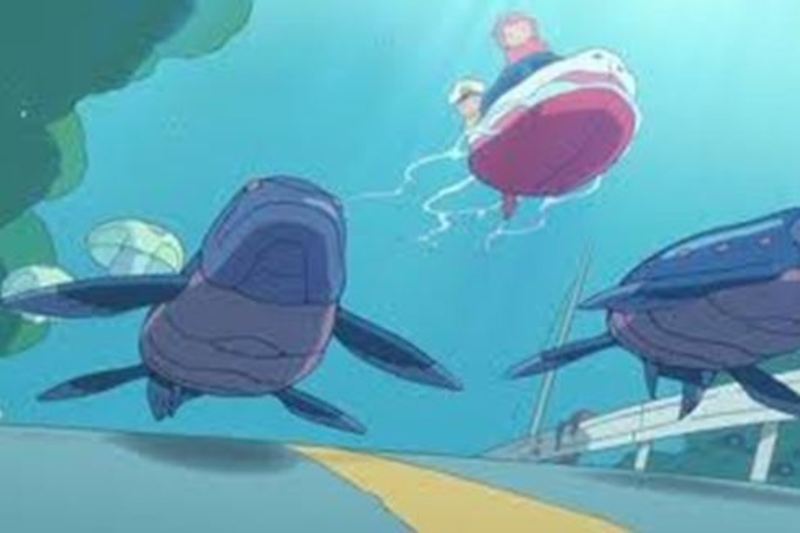 The post-disaster sea teems with ancient marine life |
This becomes clear in a memorable scene when Sosuke and Ponyo board a toy boat in search of Sosuke’s mother and go cruising above the drowned roads, houses and trees, accompanied only by gigantic prehistoric fish that swim lazily over the remnants of human civilization. Rather than being frightened by this traumatic turn of events, Ponyo and Sosuke react with an almost adult pragmatism mixed with child-like excitement. Sosuke packs a hearty lunch, while Ponyo uses her magic powers to turn the toy boat into a vessel big enough to hold the two of them. The children laugh happily at the ease with which their little boat navigates the watery world and joyously call out the names of the ancient fish that the tsunami has brought to light. The fact that Sosuke’s mother has gone missing appears almost a matter of indifference to the children, lost in the beauty of their changed surroundings. The scene is almost eerily serene, redolent of nostalgia for childhood play and also, perhaps, for a pre-human world of natural beauty. Although, later on in the film there is a heart-breaking moment when Sosuke finds his mother’s empty car and starts to cry, the overall emotional tone of the movie is strangely mellow, as if the characters were moving through a dream world where amazing events can occur but ultimately never touch them.
Given the very real trauma that natural catastrophe can inflict, Ponyo is to my mind a surprising, even disturbing vision of disaster. In some ways the tsunami appears almost as an opportunity for a lighthearted children’s adventure story. But of course there is more at stake here than mere adventure. It can be argued that Ponyo and Sosuke’s calm engagement with the tsunami and its aftermath represents a model for its child viewers as how to behave when the world comes to an end. In this regard, the film is part of a long line of what I call both “post-traumatic” and “pre-traumatic” stress films in Miyazaki’s oeuvre.
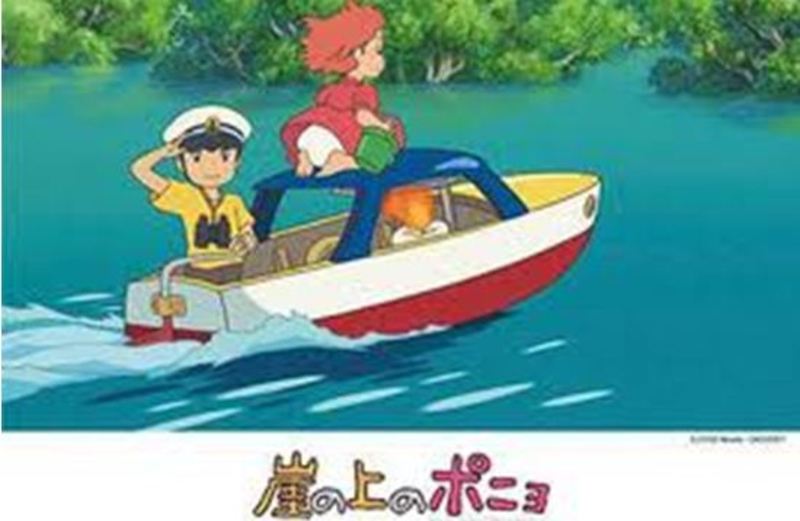 Playing in the pre-human world |
Indeed Miyazaki’s work, since his 1970’s debut television series, Future Boy Conan (Mirai Shonen Conan), which was set in a post apocalyptic world in which only a few human islands remain in the midst of a vast sea, is replete with images of disaster. Equally importantly, the films are also explorations of how humans cope with disaster. In episode after episode, Conan, the young hero of the series, uses his pluck, strength and cunning to deal with threats that are both natural and manmade, becoming the epitome of youthful resourcefulness in a threatening environment. The emphasis on Conan and his fellow young peoples’ resourcefulness is refreshing but it should be remembered that this is also a convention in children’s literature. Or, as Miyazaki puts it “One of the essential elements of most classical children’s literature is that the children in the stories actually fend for themselves.”1
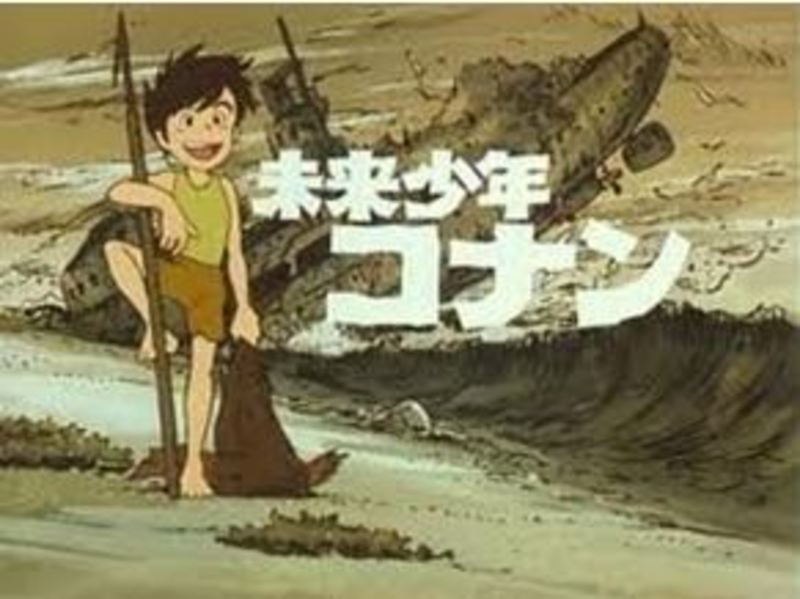 Self-reliance after civilization’s end in Future Boy Conan |
Miyazaki takes this convention to extreme lengths. After Conan, and in tandem with setting up his own animation studio, Studio Ghibli, the director has gone on to produce a number of apocalyptic films that are memorable both for their varied explorations of catastrophe as well as for their use of child or youthful protagonists, (not to mention their enormous box office success). One of the director’s most beloved films, Nausicaa of the Valley of Wind (Kaze no tani no Nausicaa, 1985), is set in a thirtieth century post-apocalyptic world in which a young princess must not only stop her fellow humans from unleashing further technological catastrophe but also has to calm a herd of gigantic insects before they inflict devastation on what is left of the world. In his 1986 film Castle in the Sky; Laputa a boy and a girl come close to sacrificing themselves in order to prevent the development of a technology of annihilation. His 1997 movie Princess Mononoke (Mononokehime), goes back in time to envision a fourteenth century Japan in which humans engender an environmental apocalypse by conspiring to kill the god of the forest and can only be stopped by the actions of a young girl raised by wolves and a young warrior from a far away land.
It should be noted that Miyazaki is merely one of many Japanese directors, in both live action and animated films, to explore the subject of catastrophe over the last 60 years. The 1950s film Godzilla and its subsequent sequels worked through the disaster of the atomic bomb while the 1973 blockbuster film Japan Sinks (Nippon Chinbotsu) envisions a devastating series of earthquakes and tidal waves that ultimately sink Japan forever beneath the waves. On the anime front, Akira the highest grossing film in Japan in 1989 began with a nuclear explosion that destroys Tokyo. In 1996-7 the iconic television series Neon Genesis Evangelion (Shinseiki Ebuangerion) riveted the country with its extraordinary vision of generational conflict on a pathological scale set against an
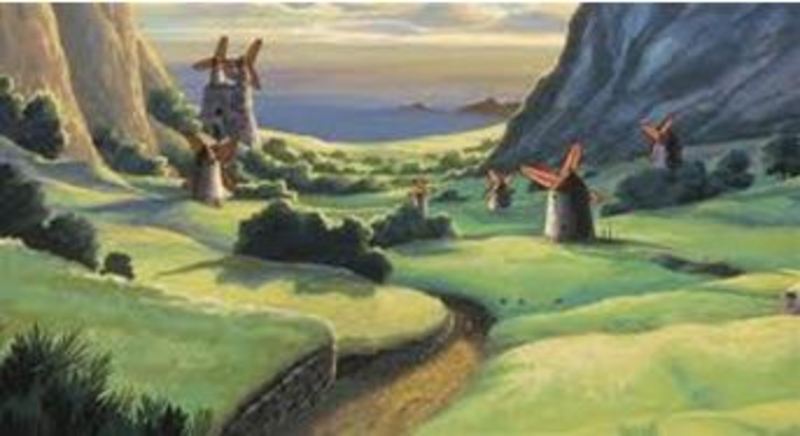 Post-apocalyptic idyll in Nausicaa of the Valley of the Wind |
Armageddon-esque battle between humans and invader aliens known as “Angels.” Even animated pornography contains one infamous example of erotic apocalypse, the notorious film and OVA series Legend of the Overfiend (Urotsukidoji). All three of the animated films mentioned also revolve around youthful protagonists.
What is this all about? One should not discount the sheer visceral pleasure in images of disaster- what Robert L
ifton describes as “the orgiastic excitement of wild forces let loose-destroying everything in order to feel alive.”2 Susan Sontag puts it even more simply as “the pleasure of making a mess.”3 This sense of all-out cathartic release is surely one aspect of why disasters have such a hold on our imaginations. After all, let us remember how transfixed we, or most of us, were by the images of the tsunami washing over Northern Japan. Furthermore, many Western films (especially American and Australian movies) revolve around apocalyptic situations, from films about nuclear anxiety such as Cold War works ranging from Stanley Kubrick’s Dr. Strangelove or Sydney Lumet’s Fail Safe to the Australian director Peter Weir’s vision of environmental collapse in his film The Last Wave.4 There are of course deeper cultural factors as well. On a universal level world ending visions are at least as old as Zoroastrianism and are deeply embedded in Judeo-Christian and Islamic civilization.
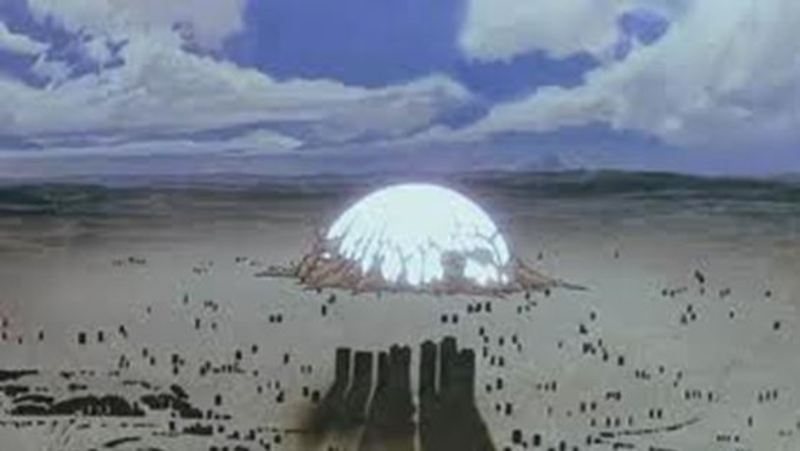
Tokyo shattered in Akira |
On the one hand apocalyptic visions may help to give meaning to our existence on earth. The eschatological mindset provides on the positive side for the possibility of purification and redemption. On the negative side, apocalyptic thought often has a tinge of revenge or even despair attached to it. And, from early on, apocalyptic notions have often been seen as warnings, frequently attached to certain behaviors that are judged as evil or wanting. In the popular culture of the postwar period end of world scenarios often revolve around nuclear anxiety, global warming, technological excess, and the dangers of either the totalitarian or uber capitalist state.
All of these aspects are addressed in contemporary Japanese cultural products, from literature, to live action cinema to anime and manga. Despite its lack of a Judeo-Christian background, Japan has a strong apocalyptic tradition, clearly linked to its fragile position in the Pacific Ring of Fire where earthquakes and tsunami are consistent occurrences. The country’s recent history, most obviously the Pacific War, the atomic bombing of Hiroshima, and environmental degradation, have nourished this mindset even more. Japan’s second Nobel Prize winner in literature, Oe Kenzaburo, wrote a two volume novel in 1973 entitled The Floodwaters have come unto my Soul (Kozui wa wagatamashii o oyobitamau), encompassing both environmental and nuclear disaster as it described the adventures of a middle aged man who builds a shelter for himself while he awaits the coming of an enormous flood.
Among all of Japan’s notable artists, however, it is Miyazaki who has most consistently given us works that revolve around world ending events to the point where we might even speak of an overall apocalyptic mindset in Miyazaki’s oeuvre. Before examining the specifics of Miyazaki’s apocalyptic vision, however, it is worth taking some time to explore the complex and fascinating relationship between popular culture and the apocalyptic imagination. In order to do that we need to step back in time to a point not too long ago when popular culture was seen as something akin to Marx’s idea of religion as the opium of the masses, a low brow escape valve through which the populace’s grievances and anxieties could be safely channeled away from any form of positive action and which, not so incidentally, served as a means of legitimizing an intellectual elite who had their hands on the tiller of the “high culture” boat. In the last three decades or so this view has shifted enormously with an increasing acknowledgement of the influence, spread and fluidity of popular culture. After all, to use a Japanese example, today’s “high culture” products such as kabuki and woodblock prints were clearly “mass cultural” items during the Edo period that spawned them.
Whether we still need to debate the question of quality, and I think that is a legitimate question, the fact is that popular culture is important on the most basic level because it is popular. Examining a popular culture product therefore means that we can be sure that this is a work that has impact on a large number of people. Now the question becomes, what kind of impact? Is a work popular simply because it reflects the wishes or fears of a large mass of people? Or can it also influence and move its audience, playing into subconscious dreams and nightmares that disturb contemporary people on a deep level?
 Firebombing of civilians in Howl’s Moving Castle |
Most commentators today would answer yes to the latter question, Or as John Treat puts it, “Popular culture, a phrase that will not really do any longer but has yet to be supplanted, is now held to be both material and immaterial, real and iconic; it is actively constitutive of experience as well as passively reflective of it.5“
My argument is that Miyazaki’s apocalyptic vision is one that does more than reflect the age -old Japanese imagination of disaster. Rather, to borrow Treat’s phrase, it is one that has actively helped to constitute it, allowing his audience, especially his Japanese audience, a chance to work through, rehearse and even perhaps do some pre-emptive thinking in relation to disaster. I call this particular dynamic “pre-traumatic stress syndrome.” In Miyazaki’s cinematic world, these stresses vary from the supra personal, explicitly – world ending fantasies to more intimate traumas of parental abandonment. Miyazaki’s visions of supra personal apocalypse beginning with Future Boy Conan (Mirai Shonen Conan) and continuing through Castle in the Sky Laputa, Nausicaa of the Valley of Wind, Princess Mononoke , and Howl’s Moving Castle, all feature certain common elements: visions of all out war involving advanced technology misused by humans, environmental collapse and implicit political commentary, and also contain a strong ideological subtext, usually expressed in terms of a (nuanced) warning as to the dangers of technology. Furthermore, they also highlight brave, competent, and independent child or adolescent protagonists who come close to sacrificing their lives for the greater good of humanity, usually in situations where some kind of technological decision must be made.
As such, they may seem quite different from the more intimate family fantasies that Miyazaki also creates. But it is in their privileging of child protagonists and all that the child focalizations imply (i.e. innocence, purity and, as one character in Princess Mononoke puts it memorably, the ability to “see with eyes unclouded”) that links them to the more intimate apocalyptic narratives of My Neighbor Totoro and Spirited Away, both of which feature children coping with the trauma of parental abandonment.
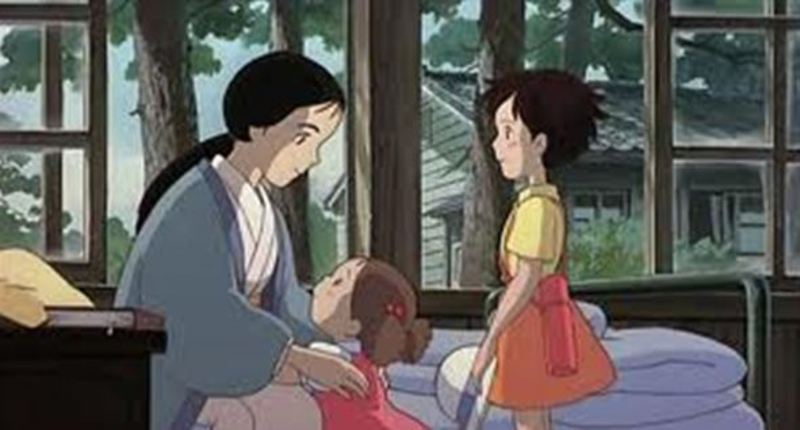 My Neighbor Totoro protagonists Satsuki and Mei visit their mother in the hospital |
Miyazaki’s use of child characters is an important element in what I see as his ability to create works of “pre-traumatic stress.” Although the director is careful to make his child protagonists quite realistic-even sullen, bratty or petty at times-their essential innocence highlights their role as embodying hope for the future. Furthermore, the child’s connection with the elemental-through play, sensation and wonder-makes them particularly appropriate vehicles for full participation in the “mess” that apocalypse creates. In this regard, it is worth noting that the adults in Miyazaki’s films seem increasingly disconnected and helpless and implicitly collaborating in the degradation around them. Especially in the director’s most recent films, the middle-aged generations are depicted as materialistic, selfish and irresponsible. In contrast Miyazaki’s children are not only innocent, they are also extremely resourceful, rising capably to challenges that would overwhelm the average adult. It is his child or youthful characters, sometimes supported by caring elderly protagonists, who bear the burden of preventing destruction and creating or (recreating) a better world.
All of the above features come into play in Ponyo, a work that memorably mixes intimate apocalypse with the suprapersonal through Miyazaki’s focalization through his two very young characters, Ponyo and Sosuke as they make their way through the post-tsunami world. On the one hand, Ponyo is a charming coming-of-age story involving two five year old children who go on an exciting adventure and learn, at a remarkably young age, to cope for themselves through their own increasing ability to rise to challenges and also through the power of their pure love for and trust in each other. Simply as a children’s adventure story Ponyo’s narrative works very effectively and one can imagine young children in the audience thrilling to the film’s delightful protagonists, its brilliantly evoked mise en scenes of ocean and magically transformed town, and the marvelous quality of its hand drawn animation that manages to be simultaneously mysterious and playful.
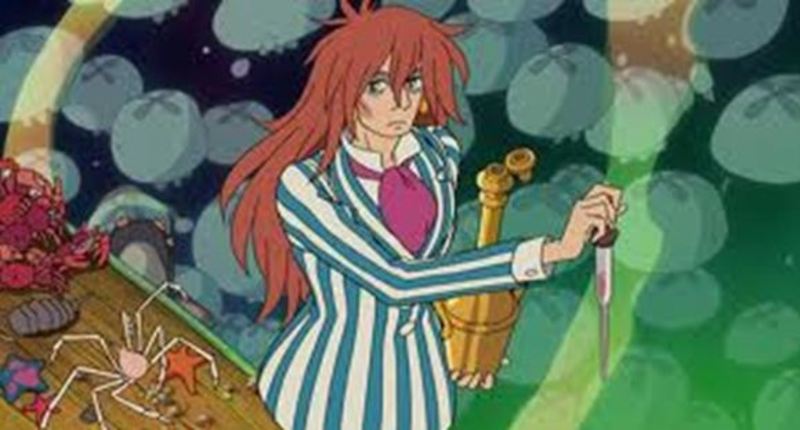 |
However, it must be re-emphasized that this charming adventure is built upon the back of an overtly apocalyptic vision and that the film’s subtextual emotional resonances suggest, at least to my mind, an attitude of angry despair mixed, paradoxically, with serene acceptance. I base my reading partly on what I see as Miyazaki’s clear ideological agenda throughout the film, an anger and bitterness towards human waste and destruction embodied in the resentful character of Ponyo’s father, the magician Fujimoto, who has literally left behind his humanity out of his anger towards how the human race has devastated the planet.
Although Fujimoto is depicted as somewhat hapless and problematic-it is he, after all, who accidentally allows Ponyo access to the magic potions that increase her powers, he also can be seen as a kind of spokesman for the natural world. His frequent references to “filthy humans” and his renunciation of his own humanity, emblemized by his deep ocean home and his inability to live normally on land, represent a savage critique of human wastefulness. From Fujimoto’s point of view at least, the tsunami and its accompanying destruction, not to mention the ocean’s return to the Devonian epoch, can clearly be read as cathartic, purifying and even redemptive.
 Fujimoto sprays seawater before him as he ventures on land |
The ocean itself becomes a live and memorably angry character in the film. The graveyard of boats that Sosuke’s father heads towards can be seen as the ocean’s revenge upon the human. This is reinforced by the immense and angry looking waves that accompany Ponyo’s progress towards reuniting with Sosuke and the scene’s accompanying musical score that contains strong echoes of Wagner’s “Ride of the Valkyries.” Ponyo herself can be read as a force of nature since it is she who triggers the ocean to let loose its apocalyptic power. On the one hand we can interpret Ponyo and her sea-goddess mother as the agents of the vengeful sea but it is also interesting to note that Ponyo gains her power through breaking into her human father’s collection of magical elixirs and drinking them for herself, another version of the age old fear of tampering with mysterious forces, i.e. technology. Watching this scene in the wake of the March 11 catastrophe one cannot help but be reminded of the waters spilling into the nuclear reactor.
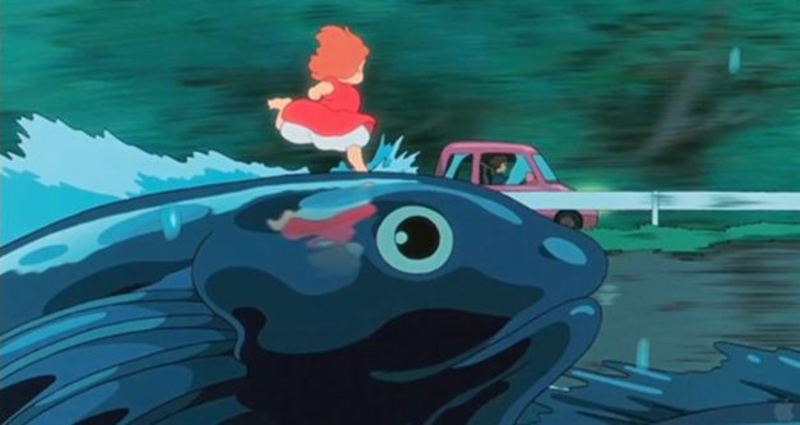 Ponyo unleashes the power of the ocean |
In keeping with the redemptive and purgative aspect of apocalypse, however, Ponyo and her parents embody both despair and salvation. In the long run Miyazaki does not let the dark undercurrents of Ponyo rise too closely to the surface. Although there are clear suggestions that the inhabitants of the town and Sosuke’s father Koichi are actually dead (twice in the film the term “ano yo” or “after life” is used), the film’s final third takes pains to give an upbeat twist to the proceedings. Ponyo’s parents reunite to help solve the crisis that their daughter has caused, promising that the genuine love between Ponyo and Sosuke will help right the balance of nature. The town’s denizens are depicted as happily making their way in a kind of floating parade (Sosuke describes it as a matsuri or “festival”), across the waters to a hilltop where they will be safe. Sosuke’s mother turns out to be safe after all, and the film’s denouement returns Koichi to land just in time for him to witness the kiss of love between his son and Ponyo that restore’s nature’s balance and ends the film.
Even more than most films in the genre of disaster and apocalypse, Ponyo allows its audience to both work through the horror of catastrophe and rehearse how to behave when another inevitably comes. The lessons of Ponyo are clear, as embodied in the scene where Sosuke and Ponyo go boating in the Devonian Sea: The current generation of adults have lost their moorings and have allowed environmental devastation and powerful forces of energy to threaten the world. It is up to our children, with their upbeat and pragmatic mindset and who still retain vestiges of respect for and wonder at nature, to stop this threat.
 The sea restored |
How to stop it? Here is where the message becomes a little cloudy in my opinion. One of my students has suggested that children in Miyazaki are in some ways reactionary forces.6 Rather than break on through to a new age that can encompass the complexities of modernity, they are usually depicted as saving the world through restoring it to a previous, better, state. This may well be the case with Ponyo, where Ponyo’s tampering with her father’s magic potions creates the Devonian sea that floods the town and returns the world to a primordial condition. The Devonian Sea, free of humanity, technology and any form of “civilization” is arguably both the most reactionary and the most radical vision of apocalypse that Miyazaki has ever attempted. Had the movie ended with the scene of the two children going out on a boat like Adam and Eve in search of a new world the movie might have been truly disturbing with its implications of mass death and cataclysmic natural shifts.
But Ponyo is a family film that ultimately cannot sustain such a definitively bleak vision. Instead we are given an upbeat ending with a rather amorphous vision of love conquering all. In this case the children are reactionary agents whose love papers over the tear in the fabric of nature that they themselves had helped to create. The film ultimately shies away from its darkest implications, allowing its family audience to get remarkably close to apocalyptic trauma but finally providing them with an escape route from that condition.
 Ponyo‘s ocean offers viewers a powerful sense of life |
We return to our question to Miyazaki. “How do you feel about Ponyo in the wake of 3/11?” My guess is that he would be cautiously optimistic. Since the earthquake, tsunami and nuclear radiation disaster, there has been much discussion in Japan of a new national spirit arising out of the ruins. Although I would never see Miyazaki as a knee jerk nationalist, it is clear from his works that, at some level at least, he sees the need of an overall crisis that will set Japan (and perhaps the world) on a better path. Let us hope that the optimistic aspects of Ponyo-hope for the future, belief in the redemptive power of love, the need to respect the literally awesome forces of nature, and an acceptance both of the inevitability of catastrophe and the necessity for transcending it, are elements that will help to shape the current Japanese imagination of disaster.
Susan Napier is Professor of Japanese Studies at Tufts University. She teaches on literature and film, including a course on the cinematic imagination of disaster called “The Cinema of Apocalypse.” Originally a specialist in Japanese literature, she is the author of From Impressionism to anime: Japan as fantasy and fan cult in the mind of the West and Anime from Akira to Howl’s moving castle : experiencing contemporary Japanese animation. She is currently working on a study of the Japanese animator Miyazaki Hayao.
Recommended citation: Susan Napier, ‘The Anime Director, the Fantasy Girl and the Very Real Tsunami,’ The Asia-Pacific Journal, Vol 10, Issue 11, No 3, March 12, 2012.
Responding to Disaster: Japan’s 3.11 Catastrophe in Historical Perspective
Is a Special Issue of The Asia-Pacific Journal edited by Yau Shuk-ting, Kinnia
See the following articles:
• Yau Shuk-ting, Kinnia, Introduction
• Matthew Penney, Nuclear Nationalism and Fukushima
• Susan Napier, The Anime Director, the Fantasy Girl and the Very Real Tsunami
• Yau Shuk Ting, Kinnia, Therapy for Depression: Social Meaning of Japanese Melodrama in the Heisei Era
• Timothy S. George, Fukushima in Light of Minamata
• Shi-lin Loh, Beyond Peace: Pluralizing Japan’s Nuclear History
• Brian Victoria, Buddhism and Disasters: From World War II to Fukushima
See the complete list of APJ resources on the 3.11 earthquake, tsunami and nuclear power meltdown, and the state and societal responses to it here.
NOTES
1 Miyazaki Hayao, Starting Point. San Francisco: Viz Media, 2009. p. 340.
2 Robert Lifton, “The Image of the End of the World’: A Psychohistorical View,” in Visions of Apocalypse: End or Rebirth, edited by Friedlander, Holton, Marx, and Skolnikoff(New York: Holmes and Meier, 1985), p. 165.
3 Susan Sontag, “The Imagination of Disaster,” in Film Theory and Criticism, edited by Gerald Mast and Marshall Cohen (New York: Oxford University Press, 1985), p. 454.
4 Interestingly, although American cinema contains many examples of films with apocalyptic themes, almost none of them revolve around children as the main protagonists. The sole exception, and this is a slight stretch, is Pixar Studio’s recent (2008) family film Wall-e, which features a robot whose childlike innocence and plucky behavior are quite reminiscent of Miyazaki’s protagonists.
5 John Treat, “Introduction” in Contemporary Japan and Popular Culture, edited by John Treat (Honolulu: University of Hawaii Press, 1996).
6 David Parker, “The Miyazaki Agenda: Agency, Innocence and Resistance in Miyazaki Hayao’s Construction of Childhood.” Unpublished Research Paper, May, 2011.





